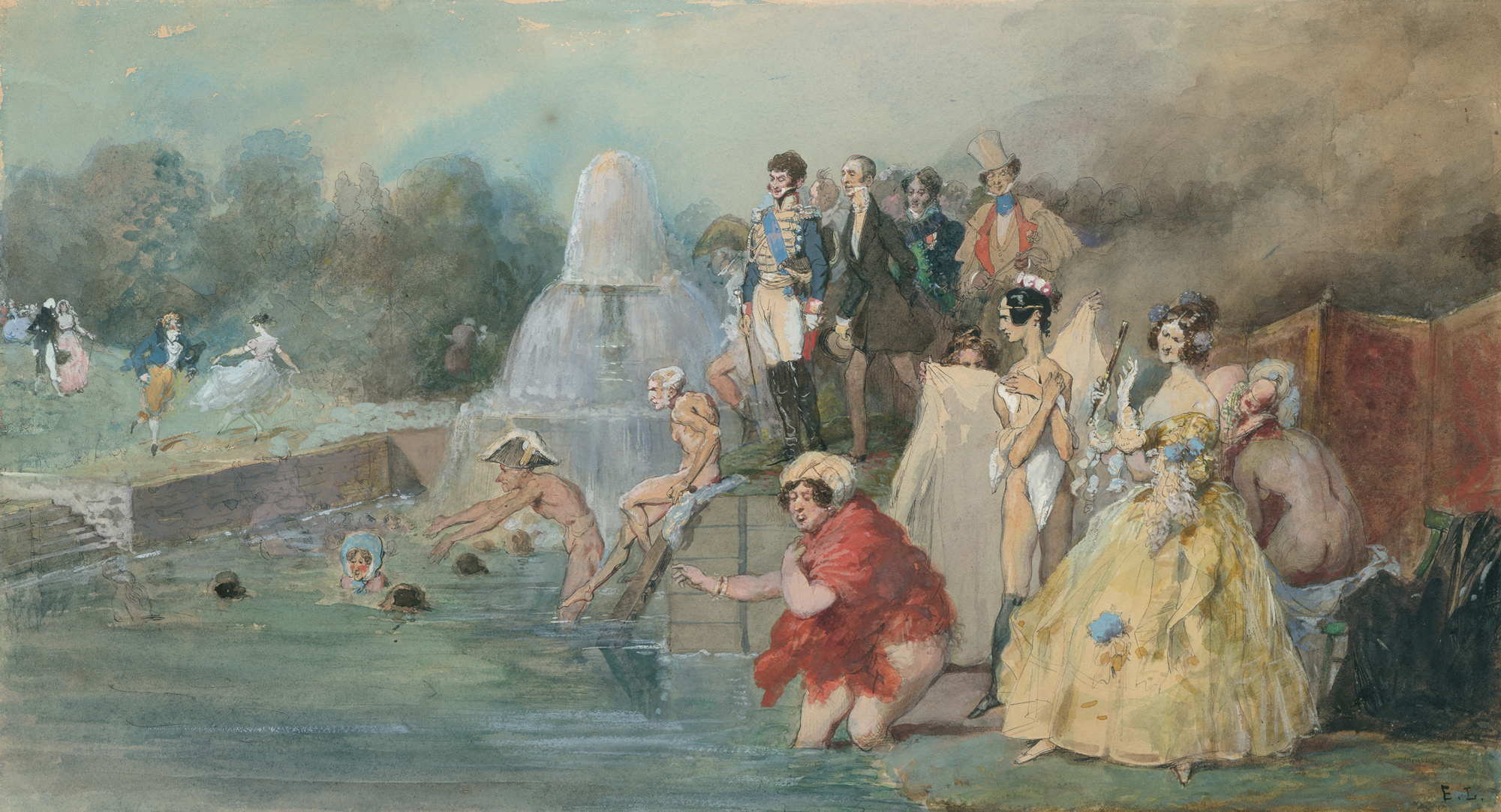Loading the page ...
Eugène Louis Lami
(1800–1890, Paris)
The Fountain of Youth. Watercolour. 25.5 x 47 cm. Monogrammed: “E. L.”.
Eugène Lami, who together with Constantin Guys and Paul Gavarni is regarded as one of the most acerbic chroniclers of his epoch, has portrayed the activities of the people gathered here in a very witty and ironical manner. The fountain of youth, traditionally a popular theme in Western art, found consummate expression above all in the works of 16th century German artists such as Lucas Cranach and Hans Sebald Beham. Lami has transferred the relevant activities to his own era, that of the “citizen king” Louis Philippe. It would be by no means presumptuous to describe this burlesque allegory as one of the artist’s principal works. A colourful group of very diverse individuals – elegant ladies, high-ranking officers, court officials and dandies – have assembled at the edge of the fountain in the vain hope of recovering their lost youth and beauty. This satirical theme offers Lami an opportunity to pull out all the stops – and he does so with great relish.
The garish scene positively throbs with innumerable bizarre and astutely observed details. In the foreground stands a spindly woman of withered beauty clad in nothing but her stockings and coyly concealing her nakedness, whilst next to her an irresolute lady in a magnificent dress shrinks from entering the chilly water. Behind her, seen from the rear, is another woman wearing an opulent feather hat who, in the process of disrobing, reveals her ample posterior. In the centre foreground, a corpulent matron ventures tentatively into the ice-cold fountain of youth. The male dignitaries in the background, some of whom wear medals, are rendered with meticulous attention to detail. Their facial features have portrait-like qualities – Marshall Soult, Louis Philippe’s Minister of War, is clearly recognisable in a prominent position, for instance – and the vividness of their characterisation is reminiscent of Daumier’s caricatures. In the middle of the picture two old men plunge undaunted into the healing waters, while on the opposite bank courtiers dance around light-heartedly, still blissfully unaware of the futility of their efforts.
Eugène Lami, the author of this work, studied under Horace Vernet and Baron Antoine-Jean Gros. Initially a painter of historical scenes, he soon turned to watercolour painting, gaining a great reputation for his humorous depiction of the customs of court and social life in Paris. His preference for watercolours was the result of his encounter with Richard Parkes Bonington in 1817 at the Paris studio of the history painter, Baron Antoine-Jean Gros. Contemporaries valued Lami’s works not just for their technical mastery, but also for their humorous and satirical themes. Endowed with an unerring instinct for expressive anecdotal detail, he portrayed the activities of fashionable Paris society and the elegant demi-monde in salons, theatres and places of entertainment and during outings on horseback in the Bois de Boulogne.
His depictions are, therefore, of considerable significance for cultural history and convey a very personal, vibrant picture of everyday life at the time of the Restoration, the era of Louis Philippe and the decadent and extravagant epoch of the Second French Empire.
Provenance: Work commissioned by Anatole Demidoff (1813–1870) for L'Histoire de mon temps; Vente San Donato, Paris Hotel Drouot, 2 July 1875, no. 36; Collection Odon de Montesquiou – Fezensac, Chateau de Courtanvaux: estate of Comtesse Odon de Montesquiou – Fezensac. Paris, Galerie Georges Petit, 9/10 December 1929, no. 5 with illustration (17,500 ff); Collection of Raoul de Montesquiou; Vente anonyme, Paris, Hotel Drouot, (Madame Roger Langaz), 27 November 1942, no. 20, illustration p. 7. Exhibition: 7ème exposition, Société des aquarellistes français, Paris 1885, no. 4. Bibliography: P. A. Lemoine. L’oeuvre d'Eugène Lami (1800–1890) – Essai d'un catalogue raisonné. Paris 1914, p. 417. Caroline Imbert has verified that Lami is the author.
